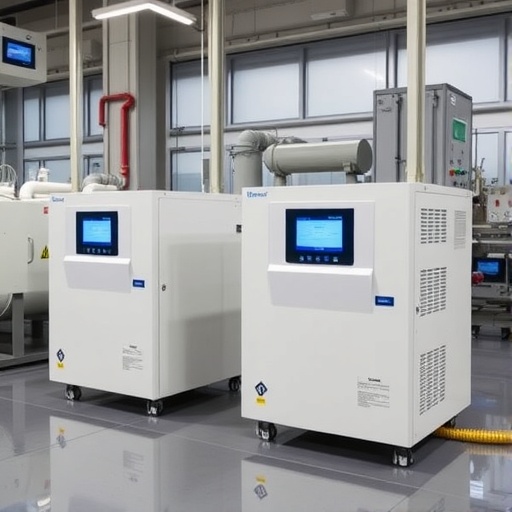In a significant breakthrough for sustainable fuel technologies, a team of researchers has announced a pioneering development in the field of electrochemical carbon dioxide reduction, achieving unprecedented energy efficiencies for multi-carbon (C₂⁺) product generation. This advancement hinges on the innovative use of uncharged porous separators, a strategic material choice that addresses long-standing challenges in catalyst performance and ion transport within electrolysers. The research, spearheaded by Miao, Fan, Wang, and colleagues, demonstrates a remarkable energy efficiency of 51% at industrially relevant current densities, marking a decisive step forward in CO₂-to-C₂⁺ conversion processes.
Electrochemical CO₂ reduction has been a focal point for scientists aiming to produce valuable hydrocarbons and oxygenates from renewable electricity, thereby creating closed-loop carbon cycles and mitigating fossil fuel reliance. However, a major bottleneck in this technology has been the limited energy efficiency, particularly during CO reduction (COR) stages, which often remain below 40%. This inefficiency primarily stems from the sluggish ion transport characteristic of traditional charge-selective membranes that separate the cathode and anode compartments in electrochemical cells.
The research team tackled these challenges by replacing conventional ion-selective membranes with a novel, uncharged porous separator. Unlike membranes that selectively conduct either anions or cations and inherently possess higher ohmic resistances, the porous separator facilitates simultaneous transport of both ion types. This design innovation dramatically reduces internal resistance and, importantly, triggers ‘superconcentration’ of cations at the catalyst interface. These concentrated cations stabilize key reaction intermediates, effectively lowering the electrochemical potential required for COR reactions.
Quantitatively, this structural modification results in a reduction of the COR voltage by approximately 150 millivolts at a substantial operational current density of 200 milliamperes per square centimeter. This decrease in voltage not only reflects enhanced catalytic activity but also translates directly into significant improvements in energy efficiency, a metric critical for commercial viability.
Historically, porous separators found limited application in CO₂ electrolysers due to the problematic crossover of hydrogen gas from cathode to anode. Hydrogen crossover has presented safety concerns and product contamination issues that compromised device performance. Addressing this, the research study capitalized on the inherent transport properties of target products—ethylene and carbon monoxide—in water. These molecules exhibit notably low diffusivities compared to hydrogen, allowing the design of a separator that is both thinner by a factor of three and more porous by 60% relative to existing designs. This dual advantage reduces the overall overpotential necessary to drive the electrochemical conversion efficiently.
Elevating operational temperature was another critical strategy employed by the team. Conducting electrolysis at higher temperatures enhances reaction kinetics and ion mobility, further reducing cell voltage. Moreover, the adoption of a nickel–iron-based anode catalyst contributed synergistically to voltage reduction, imparting enhanced oxygen evolution reaction activity at elevated temperature conditions. This multifaceted approach coalesced to lower the full-cell voltage to an unprecedented 1.95 volts at 200 mA/cm².
Beyond voltage and efficiency improvements, the electrochemical system demonstrated remarkable operational endurance, maintaining a steady energy efficiency of 51% toward C₂⁺ products over an extended period exceeding 250 hours. Such durability is essential for translating laboratory innovations into industrial-scale applications, wherein prolonged continuous operation is indispensable.
Another transformative feature of this system lies in its exceptional conversion capabilities. By achieving a carbon monoxide single-pass conversion rate of 97%, the electrolyser efficiently converts nearly all the input CO into desired multi-carbon products without the need for complex recycling processes. This high conversion mitigates energy losses commonly associated with unreacted feedstock and optimizes overall process economics.
Notably, the product gas stream post-electrolysis contained ethylene concentrations as high as 87 weight percent. This is significant from a product purification and downstream processing standpoint, as higher hydrocarbon concentrations simplify separation processes and reduce the energy footprint of product recovery.
Together, these innovations redefine benchmarks in electrochemical C₂⁺ production and set the stage for scalable, energy-efficient CO₂ utilization technologies. The insights gained underscore the crucial role of separator materials and operating conditions in dictating cell energetics and product profiles—a paradigm shift from traditional membrane-centric designs.
Looking ahead, this work paves the way for integrating CO electrolysis systems with renewable power sources, potentially enabling carbon-neutral or even carbon-negative chemical manufacturing. The combination of high energy efficiency, operational robustness, and exceptional product purity aligns well with industrial prerequisites, bringing electrochemical CO₂ reduction technologies closer to wide-scale deployment.
While this study resolved several key limitations, future challenges will center on further enhancing catalyst selectivity, extending operational lifetimes beyond hundreds of hours, and scaling up cell architectures while maintaining efficiency. Moreover, comprehensive technoeconomic analyses and life cycle assessments will be necessary to fully gauge the environmental and economic impacts of these promising electrolysers.
In conclusion, the pioneering use of uncharged porous separators represents a paradigm-shifting advance in CO₂ electrolysis, enabling over 50% energy efficiencies for multi-carbon product synthesis. By addressing intrinsic transport limitations and optimizing cell components and operating parameters synergistically, Miao and colleagues have established a new standard for CO electrolysers. This breakthrough not only contributes profoundly to the scientific understanding of CO₂ conversion but also holds transformative potential for the future of sustainable chemical production and climate change mitigation efforts.
Subject of Research: Electrochemical carbon dioxide reduction to multi-carbon products using innovative porous separators.
Article Title: CO electrolysers with 51% energy efficiency towards C₂⁺ using porous separators.
Article References:
Miao, R.K., Fan, M., Wang, N. et al. CO electrolysers with 51% energy efficiency towards C₂⁺ using porous separators. Nat Energy (2025). https://doi.org/10.1038/s41560-025-01846-1
Image Credits: AI Generated




